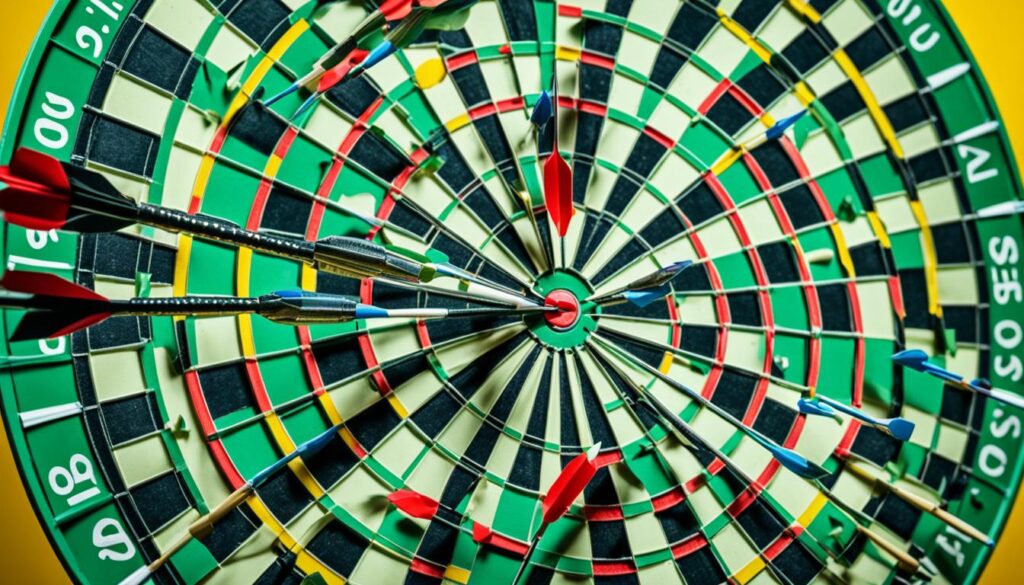The target audience is the group most likely to be into your product. It’s key to know them well. This helps make your marketing more effective. And you can connect with the right people.
To figure out your target audience, use customer data and market research. Also, make buyer personas. This way, you know who you’re really talking to. Then, you can create messages that hit the mark.
Knowing your audience is big. It makes your brand stand out and your marketing clear. Plus, it helps draw in more customers. And keep them coming back for more.
Key Takeaways:
- Target audience means the people who are most likely to want your offering.
- Study customer data and do market research to find who your audience is.
- Create buyer personas to really get what your audience wants.
- Understanding your audience helps make your marketing better. It also keeps your customers happy.
- Knowing your audience helps make your brand strong. And it builds loyalty too.
What is a Target Audience?
A target audience is a specific group of consumers who are likely to be interested in what you offer. This group is chosen using factors like age, hobbies, and what they need. They are the people who ads and brand messages are made for.
Knowing your target audience helps you make ads that they will like. This makes your marketing work better. You create messages that speak to the people you want to reach.
Benefits of Knowing Your Target Audience
Understanding who your customers are has lots of advantages. It helps create a brand that matches what’s important to them. This influences how your brand is seen and increases your followers and profits. Knowing your audience well makes them happier because you can keep your promises. It builds trust and loyalty, making them want to share your business with others.
Knowing your customers deeply helps set up a marketing plan that really works for them. By learning their habits and wishes, you can adjust your messages to speak to them directly. This not only brings in new customers but keeps your old ones happy too.
The Power of Branding
Knowing who you’re targeting lets you create a real and powerful brand. When your values match theirs, it forms a deep connection. Good branding stands out and builds trust, leading more people to pick you over others.
Effective branding resonates with your target audience and differentiates your business from competitors. It establishes trust and credibility, making customers more likely to choose your brand over others.
Customer Acquisition and Satisfaction
Understanding and catering to what your audience wants can attract new customers easily. Approaching them in ways they like, such as through ads or content, draws them closer. This not only makes new customers but keeps everyone happy. Happy customers stick around and tell others about you, gaining more trust and loyalty for your brand.
Creating Brand Loyalty
Building brand loyalty means forming close ties with those who choose your brand. Meet their needs and make their experience great every time. This secures their trust and makes them your loyal fans. They’re more likely to come back and recommend you, which helps your brand grow.
| Benefits of Knowing Your Target Audience |
|---|
| Developing a winning brand identity |
| Improving customer acquisition |
| Enhancing customer satisfaction |
| Promoting brand loyalty |
Types of Target Audiences
Target audiences can be divided into different groups for better marketing. This helps businesses to speak directly to their customers. It allows them to use the right message for each group.
Purchase Intention
Target audiences can be separated by their interest in buying things. This includes people who are looking for something specific. A company can aim at this group to sell their products better. For example, a sports gear store might want to reach people looking for sports shoes or gym equipment.
Interests and Hobbies
Businesses also look at what interests people share. By finding these connections, they can make their ads more personal. For example, a tour company might aim at people who love the outdoors. They would enjoy hiking, camping, and seeing new places.
Subcultures
Another method is to target subcultures. These are groups with shared styles or interests. They like specific things and behave in certain ways. A fashion brand might target fans of streetwear with ads that fit their style.
Segmentation
Segmentation divides audiences by things like age or where they live. This division helps businesses talk directly to different groups. For instance, a car maker could aim their ads at certain age groups or incomes. They make the message fit each group better.

By understanding what people want to buy, what they like, and even how they see the world, businesses can do better ads. This personalizes the message which attracts people more. It helps businesses reach the ones who are really interested, improving their marketing efforts.
How to Determine Your Target Audience
Determining your target audience is key in marketing. Start by looking at your current customers and do some market research. It gives you clues about who else might be interested in your product or service.
Analyze Your Customer Base
Begin by knowing who buys from you now. Find out about their age, gender, where they live, and their income. This helps you set a base for finding more people like them.
Conduct Market Research
Next, do some market research. Find out what your potential customers like and what they are looking for. This helps you see where you can fit in and meet their needs better.
Competitor Analysis
Looking at your competitors can also be helpful. See who they aim at and how they are reaching them. It’s a good way to refine your own strategy.
Create Personas
Use data and surveys to build profiles of your ideal customers. Know everything about them – from what they like to what drives them. This makes your marketing more focused and effective.
By taking these steps, you’ll know who your target audience is. This will make your marketing strategies sharper. You’ll be able to really connect with the people most likely to buy from you.
| Steps to Determine Your Target Audience | Benefits |
|---|---|
| Analyze your existing customer base | Gain insights into your current customer demographics |
| Conduct market research | Identify industry trends and gaps to fill |
| Analyze your competitors | Learn from their targeting and marketing strategies |
| Create personas | Develop a clear understanding of your ideal customers |
How to Create Target Personas with the Right Demographics
Creating target personas helps you understand and connect with your target audience. By knowing your ideal customers’ demographics, you gain insights into what they care about. This knowledge lets you tailor messages and content to meet their specific needs.
Gaining Insights Through Demographics
Different factors like age, gender, and where someone lives, matter a lot. These details help you focus your marketing to reach the right people. For instance, knowing someone’s age and gender can help tailor messages just for them.
Looking at this kind of info can show you patterns. It helps you target your marketing more effectively. This way, you can share the best content with each group of customers.
Building Realistic and Representative Personas
Creating personas means detailing who your ideal customers are. Use real data from surveys and market research. This info should include both facts like age and feelings like goals.
It’s key to make these personas real and not just guesswork. Use actual data and avoid stereotypes. Each persona should tell a story with a name, picture, and their main features.
Also, keep updating your personas as you learn more about your customers. This way, your marketing stays on track and keeps resonating with your audience.
Using Target Personas to Guide Your Marketing Efforts
Having the right target personas can steer your marketing. They help you understand what your customers need. This guides how you talk to them and what you offer.
For instance, if your target is a fit, young professional, you can make content that speaks to their lifestyle. Use the right words and visuals to catch their attention.
Always keep checking in on your personas as your business changes. This helps you stay in tune with your customers. It keeps your marketing effective and your audience engaged.
Visualizing Target Personas

| Persona Name | Demographics | Interests and Hobbies | Buyer Motivation |
|---|---|---|---|
| Emily | 25, Female, Urban area, Bachelor’s degree, Marketing professional, $60,000+ | Traveling, Photography, Yoga | Seeks authentic experiences and values sustainable products |
| David | 35, Male, Suburban area, Master’s degree, IT Manager, $80,000+ | Gaming, Technology, Investing | Looks for cutting-edge technology and convenience in products |
| Sarah | 40, Female, Rural area, High school diploma, Stay-at-home mom, | Cooking, Gardening, Parenting | Values quality and affordability in family-oriented products |
How to Reach Your Target Audience
After finding your target audience, the next move is understanding the top marketing channels to reach them. This is done by looking at social media stats and tracking how your website does. This way, your ads will be more focused and effective.
Choosing the Right Marketing Channels
To connect with your audience, pick the channels where they’re most active. Start by looking at social media stats to see which places they like. This helps create a social media plan that really gets to your audience.
“Understanding your audience’s behavior on social media is vital in determining the most effective platforms and timing for your campaigns.” – Marketing Expert
Utilizing Social Media Analytics
By using social media analytics, you can learn a lot about your audience. This helps you notice trends, find what content they like, and learn what appeals to them. With this info, you can make sure your ads and content really catch their eye.
Monitoring Website Performance
It’s key to watch how your website is doing, just like with social media. Keep an eye on things like traffic and how long people stay on your site. This data is gold – it shows you what to fix and how to make your site more appealing to visitors.
“By monitoring website performance, you can optimize your online presence and create a seamless user experience for your target audience.” – Digital Marketer
Creating Targeted Marketing Campaigns
Use what you learn from analytics and website checks to make ads that really speak to your audience. Knowing what they like means you can offer content that they find interesting. This boosts the chance they’ll interact with what you offer.
Measuring Success and Iterating
Don’t forget to check how well your ads are doing and make changes when you need to. Keep an eye on clicks, how many people actually buy what you’re selling, and how often people interact with what you post. This info tells you how well you’re doing and what tweaks to make.
Engaging with Your Target Audience
Finally, make sure you’re part of the conversation with your audience on the channels you’ve picked. Respond to their feedback and questions. This builds trust and a stronger connection. It can turn one-time visitors into loyal fans.
| Marketing Channels | Social Media Analytics | Website Performance |
|---|---|---|
| Choose channels based on audience behavior and preferences | Analyze data to understand trends and preferences | Monitor traffic, bounce rate, and conversion rate |
| Optimize content for each channel | Create campaigns based on popular content | Tailor website content and user experience |
| Engage with the audience on chosen platforms | Adjust campaigns based on analytics | Measure success and make data-driven decisions |
Examples of Target Audiences
Many companies have found their specific audiences. We will look at how some famous brands reach out and engage their audiences well.
Target
Target knows the key to success is speaking directly to different groups. They change their messages on different social media sites. This way, they touch the hearts of many and make everyone feel special.
Lightlife Foods
Lightlife Foods attracts those who care about their health and the planet. Their tasty, healthy, and plant-based products are a hit. They offer an eco-friendly option to those who are mindful of their food choices.
Apple Music
Apple Music is a haven for music fans. It has tons of songs and suggests new ones you might like. With fresh playlists all the time, it keeps music buffs happy and hooked.
Vans
Vans is the brand for skateboard lovers. They support the sport by sponsoring events and pros. Vans has really become a key player in the skating world.
Netflix
Netflix has changed how we watch shows and movies. It learns what you like to suggest perfect things to watch. By making shows across genres, it keeps viewers thrilled and satisfied.
Fortnite
Fortnite is a favorite among gamers all over. It keeps things exciting with new content and big online events. Gamers love it because it always has something fun to offer.
Summary
These cases show how vital it is to know your audience. With targeted efforts, companies can meet consumer needs effectively. This is crucial for success in today’s market, ensuring engagement and loyalty.
Conclusion
Targeting the right crowd is key for a marketing strategy to work. You should know who is most likely to buy your product. Then, your ads and messages can be made just for them.
Doing research and looking at your competition helps. Create profiles of the people you want to sell to. This way, businesses can get closer to their audience.
It’s vital to make your marketing focus on these chosen people. Develop ads that they will find interesting and useful. Ads work best when they speak directly to what the audience wants and needs.
FAQ
What is a target audience?
A target audience is a group of consumers who are most likely to enjoy your product or service. It’s chosen based on their demographics, interests, and needs. Knowing your target audience helps you shape your ads and brand interactions to fit them. It makes your messages hit home, improving how effective your marketing is.
What are the benefits of knowing your target audience?
Knowing your audience helps your business in many ways. It lets you create a brand that your customers really connect with. This means more people will like what you offer, boosting how many customers you have. You’ll also make your customers happier, building strong, loyal relationships. Loyal customers tell others about you, which grows your business even more.
What types of target audiences exist?
Target audiences come in many types. Some are looking to buy a specific product or service, while others are brought together by shared interests or hobbies. For example, groups with common hobbies form a specific subculture target. Breaking down your audience like this helps you create campaigns that really speak to them.
How can I determine my target audience?
To figure out your target audience, look at who buys from you now. This helps you understand their age, hobbies, and needs. Market research shows you what’s popular and where you can stand out. Checking out what your competitors are doing also gives you clues. By doing this, you can paint a clear picture of who you should be talking to.
How can I create target personas with the right demographics?
Start by figuring out the key facts about your audience, like their age and location. Gathering this data gives you reason behind their actions and interests. Then, use what you’ve learned to craft messages and content your audience will love. With surveys and other feedback, you can make relatable personas that lead your marketing.
How can I reach my target audience?
To reach your audience, use what you’ve learned to pick the best ways to talk to them. Look at social media and your website for clues. This helps you create marketing that they can’t ignore. Make content that fits their needs, and they’ll listen.
Can you provide examples of target audiences?
Look at companies like Target, which changes how they talk to people on social media. Lightlife Foods grabs the attention of those who love healthy, plant-based foods. Apple Music is there for music lovers. Brands like Vans focus on skateboard culture. Netflix finds the shows people love. Fortnite brings together battle royale fans. These businesses show how focusing on the right people can really work.
Why is understanding and targeting the right audience important?
Getting your audience right is key to marketing and advertising that works. If you know who you’re talking to, your message will hit home. Understanding them, through research and persona building, helps you really connect. Finding the right audience sets you up for success and growth.



















